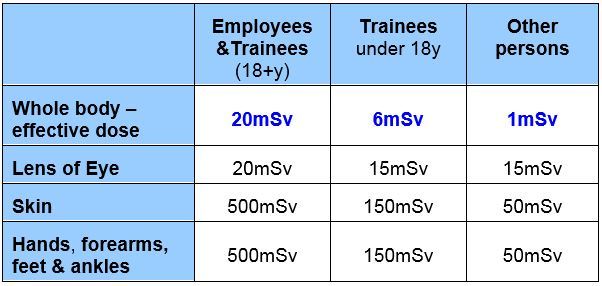IRR17 (12) - Dose limitation
Published: Sep 29, 2021
Dose limits are ‘legal limits’ and to exceed them is to commit an offence. However, they should only be seen as representing an upper boundary and not values that can be reasonably expected to be reached. One can be in breach of IRR17 where these levels have not been exceeded, if it is shown that the employer did not adopt ALARP (as low as is reasonably practicable) and comply with IRR 17 (9) - Restriction of Exposure. Dose limits are specified in Schedule 3 of IRR17 – and are summarised in the table below.

When considering the values in the table above consider the following:
- The average annual exposure from background levels of radiation in the UK (all sources) is around 3 mSv a year.
- Most employees who work with ionising radiation, including those in the nuclear industry receive on average less than 1mSv whole body effective dose in a year. (Note: average annual occupational exposures for long haul cabin crew and airline pilots are about 3mSv/year).
The above values are therefore quite significant, so careful justification (after optimisation) would be required to approach them in most typical work situations.
Notwithstanding the above , there may be circumstances where an employer can demonstrate that the 20mSv limit in the above table is not practicable. If this is the case, the employer can apply the following limits:
- 100 mSv in any consecutive 5-year period, but only if
- No more than 50mSv in any one calendar year during the 5-year period.
The above limits only apply to effective (whole body) dose. Given that occupational radiation exposure is significantly below current dose limits the employer will need to carefully justify the above additional limits. In making a case the employer will need to ensure:
(a) there is appropriate consultation with the RPA and with the affected employees
(b) there is provision of information to the affected employees and the ADS, seeking approval from HSE will also be required. Employers will also need to consult any appointed safety representative.
(c) they investigate of any suspected exposures exceeding 20 mSv in a calendar year has taken place, and this is notified to HSE;
(d) they comply with a duty to review whether the five-year limit is still appropriate at least once every five years;
(e) they place restrictions on reverting to an annual basis for the dose limit for that employee;
(f) they ensure records are made regarding the reasons for choosing a five-year dose limit.
We advise that you place employees at your establishment who DO NOT work with ionising radiation into the other persons category (they have the same level of protection as a member of the public). That said, as you read on you will see that Ionactive uses a 1mSv effective dose constraint for almost all clients working with ionising radiation (i.e. all employees regardless of their work).
Real world dose limitation
Firstly ignore the dose limits for trainees under 18 years of age, instead place them into the 'other persons' category. Read on and you will see why.
We have over 100 clients at any one time (users of ionising radiation), spanning every type of radiation use. We are Radiation Protection Adviser (RPA) to the largest user of high activity sealed sources (HASS) in the UK. That said, 98% of all our clients have employee annual exposures of less than 1mSv effective dose per year. So the dose constraint that Ionactive sets for most of our clients is no greater than 1mSv / year. This might be challenging for some users, but it ensures that the principle of ALARP is always considered.
In most cases the local rules will specify investigation levels, and perhaps operational levels lower than this, and it is these exposures that the Radiation Protection Supervisor (RPS) will be interested in on a routine basis.
